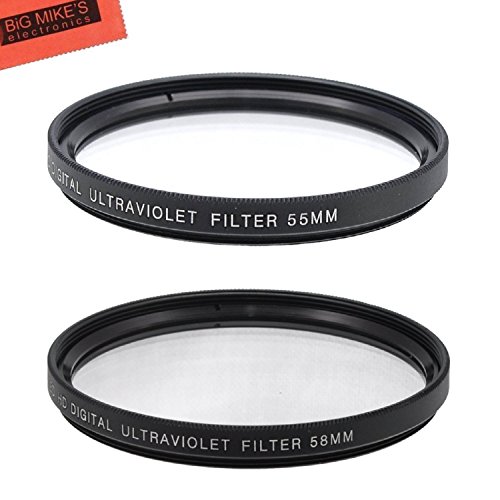- Features
- Description
- Similar Items
Filters are compatible with Nikon D5600, D3400 DSLR Camera with Nikon 18-55mm f/3.5-5.6G VR AF-P DX and Nikon 70-300mm f/4.5-6.3G ED
Protects your camera's lens from scratches, dust, dirt, moisture and fingerprints - Serves as a permanent lens protector
Quality glass material Ensures optimum performance - Helps eliminate bluish cast in images
Prevents loss of sharpness and contrast by filtering out UV rays
Includes: 55mm Multi-Coated UV Filer + 58mm Multi-Coated UV Filer + MicroFiber Cleaning Cloth
Protects your camera's lens from scratches, dust, dirt, moisture and fingerprints - Serves as a permanent lens protector
Quality glass material Ensures optimum performance - Helps eliminate bluish cast in images
Prevents loss of sharpness and contrast by filtering out UV rays
Includes: 55mm Multi-Coated UV Filer + 58mm Multi-Coated UV Filer + MicroFiber Cleaning Cloth
Binding:
ElectronicsBrand:
BIG MIKE'S ELECTRONICSEAN:
0639713357233Label:
Big Mike'sManufacturer:
Big Mike'sModel:
UV55Size:
UV FilterWarranty:
In the days of film the value of placing a UV filter in front of your lens was never questioned. In addition to dampening the image-robbing effects of atmospheric ultraviolet radiation, UV filters also served to protect the front element of your lens from dust and moisture. They also repelled the inevitable smudges and scratches that over time compromise the effectiveness of the anti-reflective coatings that go into determining how well (or not so well) your pictures turn out. Fast-forward to the modern days of digital imaging and the big argument is: "do we still need UV filters?" The answer is an unqualified "Yes."
Despite the fact that digital imaging sensors are nowhere near as sensitive to UV radiation as film, the protective properties of a UV filter on your lens are still quite justified. Regardless of how the image is being recorded, the probability of dust, moisture, smudges and scratches finding their image-compromising way onto your front lens element is equally inevitable and troublesome.
What is UV (ultraviolet) light?
The visual spectrum-the light we see with our eyes-consists of the colors red, orange, yellow, green, blue, indigo and violet. Mix them together and you get "white" light. The electromagnetic wavelengths of light are measured in terms of nanometers (nm), with the visual spectrum residing in the 390 to 750nm portion of the electromagnetic bandwidth. Just below the red end of the visual spectrum is infrared (approx 750nm to 1mm) and ultraviolet light resides just above the blue end of the visual spectrum (approx 10nm to 390nm). While we cannot see UV light, it nonetheless impacts the visual quality of the pictures we take.






